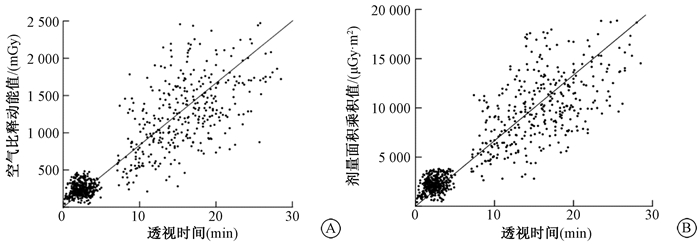心血管介入手术已经成为了冠状动脉疾病的诊治中一种安全、有效的方法。但与其他介入医生相比, 心血管介入医生术中需接受更高的辐射剂量[1]。由于电离辐射随机性生物效应没有阈值剂量[2],癌症以及遗传疾患发生率与辐射剂量成正比,辐射风险越来越受到相关医务人员的重视。目前数字减影血管造影(digital subtraction angiography, DSA)成像设备的术后采集协议均会提供透视时间、剂量面积乘积(dose-area product, DAP)值和空气比释动能(reference air kerma,AK)值。透视时间主要反映手术透视采集的累积时间。DAP是测量仪器对术中通过的射线束进行测量所得数据。文献[3]证明DAP值可作为介入手术受检患者辐射剂量评估重要证据。AK通过相关系数转换后是工作人员个人剂量当量Hp(10)的数据来源。在临床应用中,DSA设备均自带透视时间警示(fluoro timer)功能,并在累计透视时间超过预设时间周期报警,用以提醒和督促手术医生对辐射剂量的关注和人为控制,降低辐射剂量的摄入。但心血管介入手术影像采集包括透视采集和造影采集两种方式,透视时间仅间接代表透视采集辐射剂量。文献[4-5]提出透视时间作为辐射曝光数据指标缺乏准确性和其价值被高估,透视时间数据作为辐射防护工具已是过时产物。本研究展开对心血管介入术后获得的DAP值和AK值与透视时间关系的分析,并对透视时间警示价值及临床应用可行性进行评估。
资料与方法1.一般资料:回顾性分析2016年11月至2018年1月上海长海医院心内科导管室行冠状动脉造影术(coronary angiography,CAG)和经皮冠状动脉介入治疗术(percutaneous coronary intervention,PCI) 736例病例数据,数据来自长海医院数字减影血管造影(DSA)成像设备术后采集协议。分别收集性别、年龄及术后采集协议中的透视时间(min)、透视DAP(μGy·m2)、透视AK(mGy)、手术(透视+造影)DAP(μGy·m2)和手术AK(mGy)数据。排除解剖变异、严重并发症和设备故障等影响正常手术进程的病例,病例中男性473例,年龄23~90岁,平均年龄(63±11)岁;女性263例,年龄30~90岁,平均年龄(66±10)岁;CAG病例384例,PCI病例352例。对不同成像设备及CAG和PCI手术采集透视时间、DAP值和AK值进行比较分析。
2.成像设备及参数:所有病例检查均在两台德国Siemens公司(AXIOM Zee Ceiling和AXIOM Zee Biplane)血管造影成像设备上完成。检查参数设置均选择自动曝光条件心脏采集模式为CARD HDR模块,透视脉冲频率10帧/s,自动选择附加滤过器(Cu)厚度范围0.1~0.3 mm。造影脉冲频率10帧/s,无附加滤过。影像准直直径选择为16或22 cm两种,均为单平板探测器成像。
3.CAG和PCI穿刺路径和投照角度:穿刺路径均为右侧桡动脉路径,CAG采用左、右冠状动脉造影,常规采集6~8个体位,手推注射对比剂进行造影。PCI手术根据手术要求选择造影采集次数和投照角度。CAG和PCI均由心血管内科高年资主治医师、副主任医师和主任医师完成。
4.统计学处理:采用SPSS19.0统计软件进行数据分析,应用非参数Mann-Whitney U秩和检验对成像设备分组样本的透视时间、透视AK、透视DAP、手术AK和手术DAP数据分别进行比较;手术类别分组数据经正态性检验符合正态分布,应用独立样本t检验,数据以(x ± s)表示;P<0.05为差异有统计学意义。对手术AK值和DAP值与透视时间之间进行Spearman分析和建立散点图。r=0表示没有相关性,r=1表示完全相关性。
结果1.成像设备分组数据比较:Ceiling系统(294例)和Biplane系统(442例)上手术透视时间分别为(8.9±7.8)和(8.6±7.3)min;透视AK均值为(472±474)和(510±509)mGy;透视DAP均值为(4 548±4 085)和(4 255±3 781) μGy·m2;手术(透视+造影)AK均值为(703±595)和(733±614)mGy和手术DAP均值为(6 253±4 938)和(5 681±4 432)μGy·m2。组间数据比较,P值分别为0.916,0.263,0.284,0.513和0.056,差异均无统计学意义(P>0.05)。Ceiling系统透视辐射剂量(AK与DAP)与手术辐射剂量比值为67%和72%;Biplane系统透视辐射剂量(AK与DAP)与手术辐射剂量比值为69%和74%。显示不同成像设备采集的手术辐射剂量中,透视辐射剂量均占有较高比值。
2. CAG和PCI手术中的透视时间、AK值和DAP值:结果显示CAG和PCI手术透视时间、透视AK值、透视DAP值、手术AK值和手术DAP值,比较差异均具有统计学意义(t=-49.732、-39.837、-37.562、-39.430、-37.640, P<0.05),见表 1。PCI透视辐射剂量(AK和DAP)与手术辐射剂量比值为74%和78%。PCI术中透视辐射剂量是手术辐射剂量的主要来源。
|
|
表 1 不同冠状动脉手术透视时间、透视辐射剂量和手术辐射剂量数据比较(x ± s) Table 1 Comparison of fluoroscopy time, AK and DAP values of fluoroscopy, total AK values and total DAP values from different types of cardiovascular interventions (x ± s) |
3.透视时间与辐射剂量的相关分析:透视时间与术中AK值(r=0.822)和DAP值(r=0.844)均呈显著正相关性(P<0.001),见图 1。

|
A.空气比释动能; B.剂量面积乘积 图 1 736例心血管介入手术透视时间与辐射剂量相关散点图 A.Air kerma; B.Dose-area product Figure 1 Correlation scatter plot between fluoroscopy time and radiation dosages during 736 cardiovascular interventions |
讨论
辐射防护无论在短期还是在长期的职业环境管理中都是至关重要的。新技术的应用鼓励操作人员灵活使用减少辐射摄入的防护技巧和应对措施,包括保持人员与X射线管之间的距离,采用低剂量曝光技术,减少透视与造影采集帧数等手段[6-7]。透视时间的延长意味着随透视采集帧数增多辐射剂量的增加,DSA设备均设计了透视时间警示设置,术中累计透视时间超过预设时间段便发出声音报警,实时提醒操作人员和采取干预措施。本研究通过对心血管介入手术中透视时间和辐射剂量的关系的研究,进一步阐述透视时间警示功能在临床应用中的可行性价值。
本研究设备分组数据比较发现,在不同设备上透视剂量均占有较高比例。分别以AK和DAP作为辐射剂量依据,计算样本透视与手术辐射剂量比值,结果均达到70%左右。对CAG和PCI分组进行透视剂量与手术剂量比较,PCI透视剂量占比明显高于CAG,可以推断随着手术复杂程度增加,透视辐射剂量是心血管介入手术辐射剂量的主要来源。对透视时间与手术AK和DAP之间的相关性分析,结果表明透视时间与术中辐射剂量具有较高相关性,与Stratis等[8]文献报道相符。对于Skripochnik和Loh[4]提出透视时间与手术辐射剂量无明显相关性的结果,文中描述透视辐射剂量(AK和DAP)与手术辐射剂量比值仅为36%和38%。分析该文献研究数据主要来自外周动脉介入手术,导致不同的分析结果。
心血管介入手术造影影像每帧采集相比透视采集需要更高的辐射剂量[9], 但术中长时间的透视促使术中透视采集帧数明显多于造影帧数,导致透视辐射剂量远高于造影。本研究发现在冠状动脉PCI治疗中,术中透视一直维持较高的辐射剂量,在手术辐射剂量中始终占有极高比例。心血管介入手术中降低透视时间或减少透视帧数可明显减少术中辐射剂量[10],透视时间报警设置可能是最有效利用人为方式降低透视剂量的对策。透视时间在心血管介入手术中作为辐射监测依据有一定的应用价值,可作为术中辐射剂量的参考指标。尽管AK值和DAP值为手术期间的辐射剂量的监测提供了更准确的数据来源,但鉴于术中使用AK和DAP等相关辐射数据作为警示参考,相关人员需具备相对专业的辐射防护理论知识和理解能力。临床血管介入医师对两者数据并非都具备敏感性,而术中透视时间报警设置所给予的时间概念的提示可能更容易被医护人员接受和产生满意的警示效果。透视时间警示设置在心血管介入临床应用中,使手术人员和受检患者从中受益,具有临床可行性和实用性的价值。
利益冲突 无
作者贡献声明 丁海岭负责数据处理和本论文的撰写;王永春参与数据审核和分析处理;王敏杰负责指导论文修改
| [1] |
Toossi MT, Mehrpouyan M, Nademi H, et al. Preliminary results of an attempt to predict over apron occupational exposure of cardiologists from cardiac fluoroscopy procedures based on DAP (dose area product) values[J]. Australas Phys Eng Sci Med, 2015, 38(1): 83-91. DOI:10.1007/s13246-014-0326-1 |
| [2] |
Jaco JW, Miller DL. Measuring and monitoring radiation dose during fluoroscopically guided procedures[J]. Tech Vasc Interv Radiol, 2010, 13(3): 188-93. DOI:10.1053/j.tvir.2010.03.009 |
| [3] |
Bor D, Olgar T, Onal E, et al. Assessment of radiation doses to cardiologists during interventional examinations[J]. Med Phys, 2009, 36(8): 3730-3736. DOI:10.1008/1.3168971 |
| [4] |
Skripochnik E, Loh SA. Fluoroscopy time is not accurate asa surrogate for radiation exposure[J]. Vascular, 2017, 25(5): 466-471. DOI:10.1177/1708538117698342 |
| [5] |
Kuon E, Robinson DM, Empen K, et al. Fluoroscopy time-an overestimated factor for patient radiation exposure in invasive cardiology[J]. Rofo, 2005, 177(6): 812-817. DOI:10.1055/s-2005-858189 |
| [6] |
Kastrati M, Langenbrink L, Piatkowski M, et al. Reducing radiation dose in coronary angiography and angioplasty using image noise reduction technology[J]. Am J Cardiol, 2016, 118(3): 353-356. DOI:10.1016/j.amjcard.2016.05.011 |
| [7] |
Seiffert M, Ojeda F, Müllerleile K, et al. Reducing radiation exposure during invasive coronary angiography and percutaneous coronary interventions implementing a simple four-step protocol[J]. Clin Res Cardiol, 2015, 104(6): 500-506. DOI:10.1007/s00392-015-0814-7 |
| [8] |
Stratis AI, Anthopoulos PL, Gavaliatsis IP, et al. Patient dose in cardiac radiology[J]. Hellenic J Cardiol, 2009, 50(1): 17-25. |
| [9] |
Farajollahi A, Rahimi A, KhayatiShal E, et al. Patient's radiation exposure in coronary angiography and angioplasty:the impact of different projections[J]. J Cardiovasc Thorac Res, 2014, 6(4): 247-252. DOI:10.15171/jcvtr.2014.020 |
| [10] |
冯俊, 王爱玲, 程景林, 等. 不同类型心血管介人手术辐射剂量分析[J]. 中华放射医学与防护杂志, 2012, 32(4): 416-419. Feng J, Wang AL, Cheng JL, et al. Analysis of X-ray radiation doses from different types of intervention for cardiovascular patients[J]. Chin J Radiol Med Prot, 2012, 32(4): 416-419. DOI:10.3760/cma.j.issn.0254-5098.2012.04.024 |
 2020, Vol. 40
2020, Vol. 40


